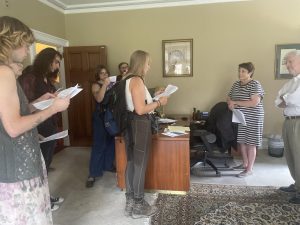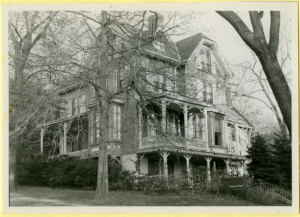Linda Midgett’s documentary, “The Line,” illustrates the reality of living in poverty in the United States as opposed to the commonly perceived standards. Chatham University hosted a viewing of Midgett’s film on October 23 in Eddy Theater sponsored by the Naturality campus organization.
The documentary showcases the new face of poverty in the United States, those who are living at or above the recognized poverty line. The film was funded by several organizations, such as Sojourners, World Vision, and Bread for the World.
Midgett’s film addresses the stereotypes that surround poverty in the United States and the shame that comes as a result. “The Line” gives specific faces to those who are living near or below the poverty line by following those for whom this is a reality.
Midgett had no trouble in finding subjects to focus on and feature in her film. Locating these subjects as they are dealing with poverty and hunger wasn’t the hard part, but finding those who were willing to be featured on film was not quite as easy. This issue became one of the major challenges in her film, but also served to put emphasis on one of the driving points to which it aims to bring attention.
“For me, it highlighted how much shame is associated with being in poverty,” Midgett said of the dilemma.
The film takes a unique stance on the issue of poverty in the United States. It focuses specifically on individuals and brings their loves and their stories to the screen.
“I felt like one of the most important things I was trying to do with this film was to break down stereotypes of who poor people are, what they look like, what they sound like, and the best way to do that was just to let them talk,” said Midgett of her film.
The film follows four people as they tell their stories to Midgett’s camera and the entire audience.
The viewers meet John, a man who is living in suburban Chicago and finds himself dependent of food banks to feed his entire family after losing his prized job in the banking industry, in which he was making a six-figure salary.
The viewers also meet Sheila, who grew up in the Chicago area in poverty, but has now managed to escape it. Presently in the documentary, she is facing financial instability after suffering through a debilitating accident.
Another featured person is a man named James, who has moved from New York to North Carolina in an effort to find employment, but is still barely making enough to survive on each day. Even though he is working long and difficult hours, he is still hovering dangerously near the poverty line.
Finally, the film also follows Ronald, who is working as a shrimper along the Gulf Coast. Both the BP oil spill and Hurricane Katrina have drastically altered his livelihood, making him yet another working American living near the poverty line and struggling to get by.
“As individuals, they’re all so compelling, and have such unique perspectives; just the process of listening to them, in and of itself, breaks down stereotypes,” Midgett said. “Instead of thinking of ‘poor people,’ it becomes, ‘oh, that’s Sheila, that’s John.’ The more you know people by name and know they’re human beings, not statistics, the more it changes your heart.”
Linda Midgett’s film is successful in showing that the face of poverty in the United States is no longer what people think it is or what expect it to be. It could be anyone one passes on the street.
As “The Line” shows its audience, the face of poverty has become much more close to home, and the poverty line is hovering near by anyone who has had hours cut from their works schedule or is facing unemployment.






